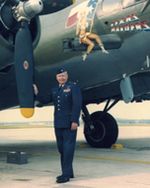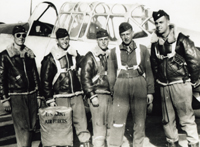 Colonel Thomas J. Tredici, MD (b.1923) ) had a long and interesting career in the military even before he became an ophthalmologist. It began in 1942 when Tredici enlisted in the Army for pilot training— before the Air Force was established within the Armed Services in 1947, the Army trained cadets for flight. Tredici was tested and selected to be trained as a bomber pilot and eventually was assigned to a B-17G Fortress II aircraft with a crew of 10.
Colonel Thomas J. Tredici, MD (b.1923) ) had a long and interesting career in the military even before he became an ophthalmologist. It began in 1942 when Tredici enlisted in the Army for pilot training— before the Air Force was established within the Armed Services in 1947, the Army trained cadets for flight. Tredici was tested and selected to be trained as a bomber pilot and eventually was assigned to a B-17G Fortress II aircraft with a crew of 10.
In 1944 Tredici was deployed to Great Britain with the 751st squadron of the 457th Bomb Group of the 1st Bomb Division of the 8th Air Force. Thomas Tredici and his crew regularly flew between 30,000 and 35,000 feet without pressurization. Col. Tredici recalls that the most common injuries were frostbite and ocular trauma if the aircraft came under fire. In total Tredici flew 18 combat missions over Germany between November 1944 and June 1945.
 Influenced by his interactions with flight surgeons, Tredici earned his bachelors degree in 1949 and immediately entered medical school at the University of Pittsburgh. His specialization in ophthalmology allowed him to become an instructor at the USAF School of Aerospace Medicine. In 1987 Col. Tredici became the last WWII pilot to retire from active duty in the Air Force, but continued to work as a Senior Scientist with the Aerospace Ophthalmology Branch until 2011. In 2012 Dr. Tredici sat down to talk about his life and experiences for the Museum of the Eye® Oral History Project.
Influenced by his interactions with flight surgeons, Tredici earned his bachelors degree in 1949 and immediately entered medical school at the University of Pittsburgh. His specialization in ophthalmology allowed him to become an instructor at the USAF School of Aerospace Medicine. In 1987 Col. Tredici became the last WWII pilot to retire from active duty in the Air Force, but continued to work as a Senior Scientist with the Aerospace Ophthalmology Branch until 2011. In 2012 Dr. Tredici sat down to talk about his life and experiences for the Museum of the Eye® Oral History Project.